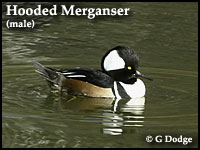Having been absent from the Wetlands since the third week of March, Hooded Mergansers have returned. Three males and two females were first seen swimming and diving in the Wetlands on 12 November. If you’re not exactly sure of what a Hooded Merganser is, there’s a photo at left. To see a brief video of both a male and female of this attractive fish eating duck, go to: http://grdodge.com/gdonline.htm and click on “Hooded Merganser.”
With the arrival of the mergansers, there are three bird species in direct competition for the Wetland’s fish. I expect we’ll see a Pied-billed Grebe arrive soon, but for now the contestants are Hooded Merganser, Belted Kingfisher, and Great Blue Heron.
Two observations on the resident Great Blue Heron: It has apparently learned to use ducks and geese to secure prey for itself, and it eats quite a few crayfish.

Over the past few weeks I’ve noticed the Museum’s Great Blue Heron stalking prey in close proximity to both the Mallards of the Wetlands and the visiting Canada Geese. As they (the ducks and geese) tip-up to feed on the vegetation and odd invertebrate, the heron flies, walks or swims (yes, swims), over to the feeding waterfowl, often getting quite close. The geese at first protested this intrusion into their “space” with a lot of head-bobbing and cackling, but the heron persisted. The ducks and geese now seem to accept the heron as part of their daily routine.


Great Blue Herons usually hunt alone, but this one has apparently noticed a correlation between the foraging waterfowl and the availability of its prey, or so it seems. One of two things could be happening. One, while feeding on the vegetation, the ducks and geese disturb the bottom and surrounding area causing whatever fish, tadpoles, or other heron prey items hiding or resting therein to flush, making themselves visible and available to the heron. Or two, the fish are actually attracted to the area because of the disturbance caused by the feeding waterfowl which may stir up small invertebrates that the fish eat. Whichever it is, the heron zeros in on the waterfowl whenever they’re feeding.
Recently, a similar behavior was documented at a pond at Duke Gardens here in Durham, a few miles southwest of the Museum. While people visiting the pond fed bread to the local ducks, the pond’s resident catfish took advantage of the free meal tossed in the water for the ducks and began gorging on the bread themselves. (I don’t recommend feeding bread to ducks; in fact, I discourage it – whole corn is better. Neither is OK at the Museum!) Upon seeing the fish, the resident heron swam over and snagged one of them. Has our Great Blue Heron been to Duke Gardens and witnessed this behavior? I don’t know.
The two situations above are slightly different, however; at Duke Gardens the fish were attracted by the bread meant for the ducks, but no one feeds the ducks (and indirectly the fish) at the Museum. I don’t know if the Duke Gardens heron now associates the feeding of the ducks with the availability of a meal because I didn’t witness the incident myself and have not followed up on it. However, our bird, the resident Great Blue Heron in the Wetlands, apparently does associate ducks and geese with dinner, at least while the waterfowl are actively foraging for their own food. As already mentioned, whenever the geese or ducks are out in the water feeding, the heron watches closely and usually flies over, intent on snagging a meal.
Now, to the crayfish. Several weeks ago I noticed a rather large pile of crayfish parts (claws, legs, and various other exoskeletal pieces) on the boardwalk just outside of the entrance to the main Black Bear Overlook. At first I thought a Raccoon was somehow responsible for the mess. However, the pile looked as though it had been deposited from a considerable height – it was somewhat splattered about on the boardwalk, with some of the pieces several feet from the main pile.
There is a Loblolly Pine next to the boardwalk at the exact location where the crayfish parts were found. Some forty feet above, the tree has branches extending out over the boardwalk. Great Blue Herons regurgitate, in the form of a pellet (much like owls and hawks), the parts of their prey that can’t be digested, like fur, bones, and exoskeletons. Since the initial observation, there has been much “whitewash” (poop) in the same spot and more, somewhat smaller, piles of crayfish parts. It appears as though our Great Blue Heron sometimes roosts in the Loblolly high above the boardwalk. The rest, you can guess.
